| From More to Four |
Marcy Petrini
August, 2022
At Convergence® last month I wore this shawl which I had named “Ripples on Knoxville Lakes.” I had originally planned to submit it to the fashion show, but life interferes with weaving sometimes and the shawl got barely finished in time for the conference. Instead, I wore to the fashion show event.

On the way there I met a colleague who admired my shawl and asked: “Eight shafts?” “No, I said, forty.” “Oh, she replied, I will never be able to weave that.”
That’s true and it isn’t. She wouldn’t be able to weave that exact shawl unless she had 40 shafts, but the idea of the shawl came from the many lakes in the Knoxville area, and I imagine ripples any time we have standing water. The concept of ripples on water, however, can be woven with many fewer shafts.
For the 40-shaft version I started with a pointed twill in the threading and treadling, and then I “played with” the tie-up which I then converted to a lift plan. The drawdown is below.

Here is a close up of the fabric. The warp is Tencel™, variegated and dyed by my friend Margaret Pittman. Sadly, she is no longer able to dye. She called this yarn Atlantic Moonglow with purples, and blues. The weft is 20/2 lilac silk.

In response to my colleague, with fewer shafts, what could we could weave?
With fewer shafts, I find it easier to manipulate the threading.
For an eight-shaft version, I started with a pointed twill as shown below with the intention of making it a diamond which then can be rounded in some way, the same thought I had when designing the 40-shaft version.

To round it, we can elongate the threading or the treadling or both. With fewer shafts I generally prefer to manipulate the threading, so I can think of my motif even before I consider the treadling steps.
As shown below this becomes an undulating pointed twill. In my experience with undulating twills, the floats can get so long to make the fabric unstable. Here I chose to double the threads on shaft 4 and 6. For a more rounded shape, we could triple some and double others, but again, long floats have to be assessed.

Next, I chose a tie up. In this example I started with 2/1/2/3. I then placed an additional tie on shaft 4 to delimit the float. This way there aren’t any floats warp or weft-wise longer than 5 threads. Depending on the sett of the warp, that number could be larger for a close sett or smaller for a wider sett. Below is the drawdown for this step.

Looking at the drawdown, we see that there are two concentric rounded figures, not quite circles for sure, but reminiscent of a ripple. But we could add more, as shown below.

This is an extended undulating pointed twill. There are other options, of course, but the process to design the motif is the same.
What about 4 shafts? The process is the same here, too.
Instead of a pointed twill, I started with a bird’s eye twill, so the repeat is longer and there will be a nice center. I used the traditional bird’s eye twill treadling with the 2/2 tie-up, as shown below.

Next, I doubled threads on shafts 2 and 4, rounding the appearance a bit. Not doubling adjacent shafts avoids long floats. In this example there are no floats longer than 5 thread long.

Here is my final version: an extended undulating bird’s eye twill. It could be rounded more, but I will leave that up to you.

And, yes, you could weave this on a rigid heddle loom. Guatemalan and other native weavers do amazing designs with a pickup stick. It does require some patience.
Twills that have lines going at different angles change how we see the pattern and the color that they reflect, especially as they move. If we use shiny yarns, as I did in my shawl with Tencel™ and silk, there are actually two types of reflectivity: one is the usual light bouncing back from the color not absorbed. We see the purples and blues in my shawl. The other is called specular reflectivity which is ambient light that shines back (“Specular” comes from the Latin word for mirror, and specular light results from reflections as if by a mirror). The shawl appears lighter in spots where specular reflections bring out highlights – especially at the folds. Luminescence can result from these visual effects.
The process I have described here to obtain rippling can be applied to many other motifs. Drawdown software is very useful.
Happy Weaving!
Marcy
| Tied Lithuanian |
Marcy Petrini
July, 2022
Recently my 100-year-old Mom moved to an assistant living facility. As we were packing what she would be taking with her, deep down in a drawer I found a small runner woven in Tied Lithuanian. I had completely forgotten I had given it to her. I wove it with the three colors of the Lithuanian flag: yellow, green and red. The blocks of the green section in the middle are woven with a variegated yarn and treadled differently than the yellow and red sections.

It was a bittersweet finding. On one hand, I am glad to have it because it’s one of the earliest samples of tied unit weaves that I have woven. On the other hand, she must have stashed it away because it was “too precious” to use and ended up not enjoying it. That saddened me.
Mom was born in Lithuania but left as a refugee when the Russians occupied Lithuania during World War II. She was separated from her family. She met my Italian Dad in Germany, they got married and moved to Italy. Dad had been a prisoner of war in Germany because he refused to fight on the Mussolini and Hitler side. Dad was freed by the Americans.

The Vatican hosted several embassies of the countries occupied by the Russians so that the displaced people could keep a community and preserve their heritage. As a child I remember going to the Lithuanian embassy and seeing beautiful regional costumes that the ladies wore. I was in awe of the embroidery. I had learned to embroider from my aunt, but not that intricate!
It turns out that the “embroidery” was actually weaving, and it was many years later that I learned about some of the techniques. Card weaving and pick up are popular, but so is Tied Lithuanian.
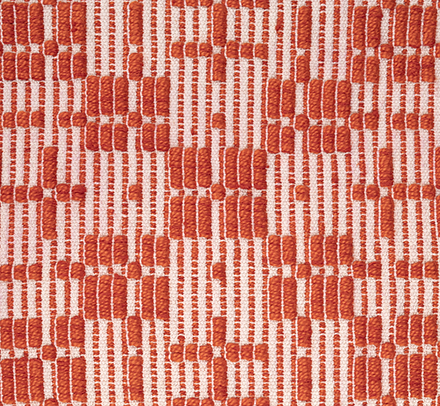
Lithuania was freed from the Russian aggression in 1989. I am quite sure that I wove the runner for Mom earlier. I was so inexperienced with tied unit weaves, that I didn’t know what are traditionally considered the front and the back. I can tell from the folded hem that I switched them. Below is the back which I thought was the front.

Ironically, I found the runner when I was in the middle of writing my monograph An Eight-Shaft Primer of Tied Unit Weaves for my upcoming Convergence® seminar. Tied Lithuanian is part of it.
What is Tied Lithuanian? Using Donna Sullivan’s classification from her book Summer & Winter, Tied Lithuanian is a double, two paired ties, with a 1:2 ratio. It means that there are two pattern shafts (“double”) and two ties together (“paired”). For each block the ratio is one tied-down thread for two pattern shafts. The tied-down shafts are 1 and 2. The pattern shafts for block A are 3 and 4.
Tied Lithuanian and Tied Latvian have the same threading. They differ in the treadling.
Below is a sinking shed drawdown. There are three blocks on eight shafts. In this example, each block is repeated. The top portion with the dark pink weft is the Tied Latvian treadling. This is typical of tied unit weaves. Each tie-down shaft is paired with the pattern shafts to treadle the block. The two pattern picks are repeated as needed to square the block.
The bottom portion with the green weft is the Tied Lithuanian treadling. It uses only one pick per block, the one with shaft 1 as the tie-down thread.
In the middle in light blue are the two tabby picks, odd vs. even. As in all tied unit weaves, each pattern pick is flanked by tabby picks.
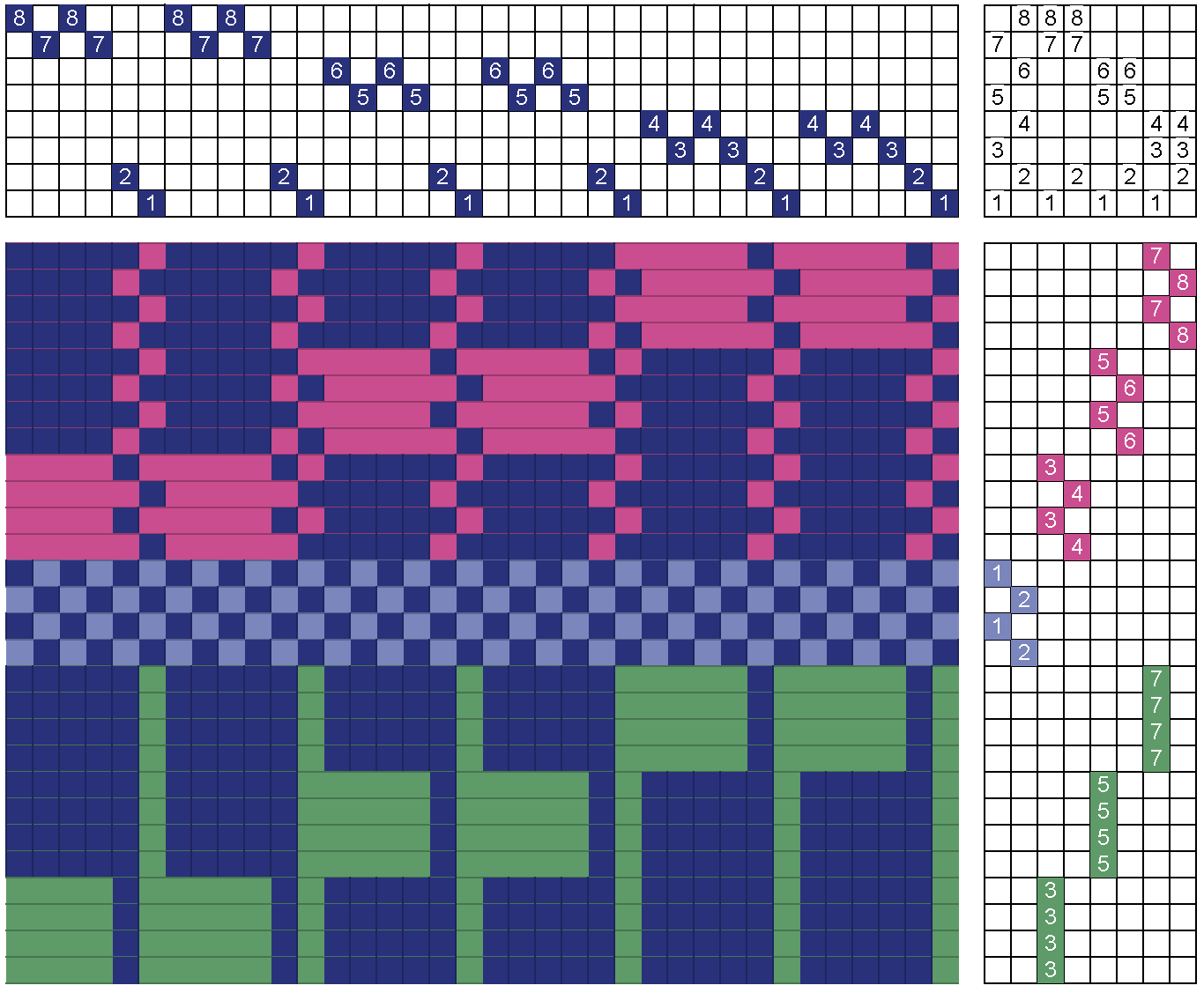
The runner for Mom was woven on 10 shafts, the directions long gone. We can see the characteristic columns of ties on shaft 1 in the background, on shaft 2 between blocks seen in the drawdown.
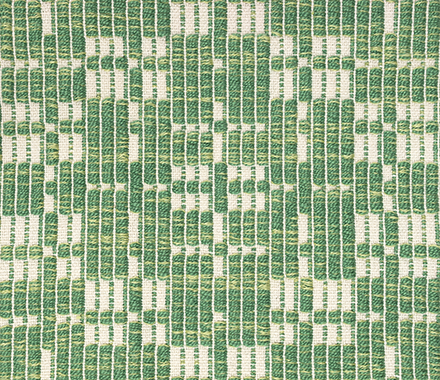
Whether you will ever weave Tied Lithuanian or not, there is a lesson to be learned here: use your textiles, those you weave for yourself and those given to you by dear ones. My throws and blankets, woven and knitted, some with handspun, are on all the couches and chairs in our living spaces. They are ready to warm humans and cats. You may think they are worse for wear, but I think they have just been loved.
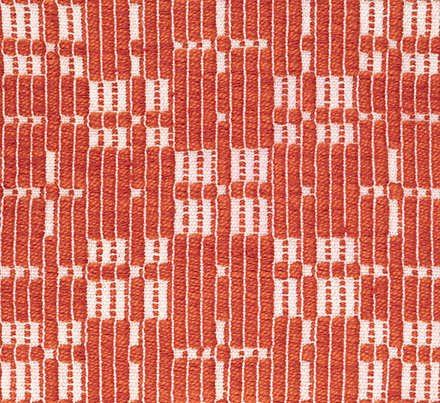
I hope to see you at Convergence®, maybe even in one of my seminars – vaccinated and masked, we will both be safe.
I would love to see you there!
Happy weaving!
Marcy
| Swedish Lace or Droppdräll? |
Marcy Petrini
June, 2022
A long, long time ago in a region far, far away, a group of weavers were looking for new patterns to try. They came across a Swedish book and found an interesting structure. It was called something like droppdräll, which was hard to pronounce and difficult to spell. But they wove it and liked it. The problem now was to tell others about this weave. They weren’t sure of the meaning of the word. Someone said: it looks like a lace weave, and it is Swedish, so let’s call it Swedish Lace.
Many moons passed and this weaver decided to try Swedish Lace. We had used Mary Black’s book New Key to Weaving when I took weaving courses in Rochester, NY, for nearly one-year. Then I moved. Of course, we had not woven every structure in the book, so I wanted to “fill the holes” and came across Swedish Lace.
In her book Mary Black describes the structure as having three repeats of each of the two six-thread blocks as shown in the drawdown below.
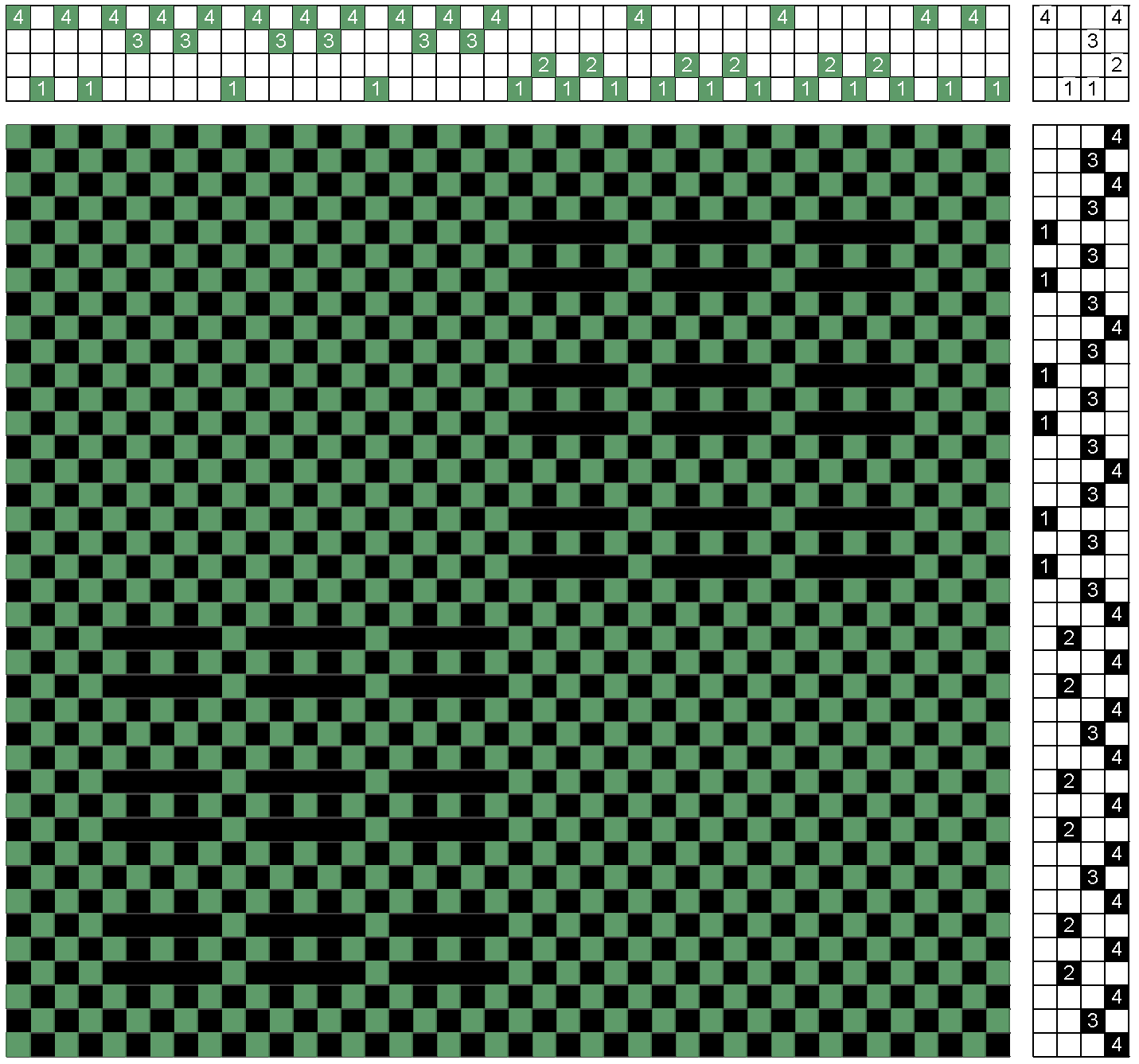
She also says: “It is this sixth thread which, when crossed by a weft thread forms the little window between the units of the blocks which is a distinguishing feature of the weave.”
I wove a small mat, long lost, but similar to the sample below that I have woven more recently.

I liked the structure and promised myself that I would return to it – later.
Many more moons passed, and I eventually settled down to weaving scarves and shawls, primarily with twills and satins, but every few pieces, I decide that I need to try – or re-try – something other than another twill.
So, not too long ago, I decided I would weave a Swedish Lace shawl. The impetus was that I would be presenting at Convergence® a seminar on Rectangular Float Weaves which include Swedish Lace.
The finished shawl is below. As I was weaving, I kept on thinking that the structure looked similar to huck and finally I decided I needed to figure out the difference – besides Mary Black’s “little windows.’”
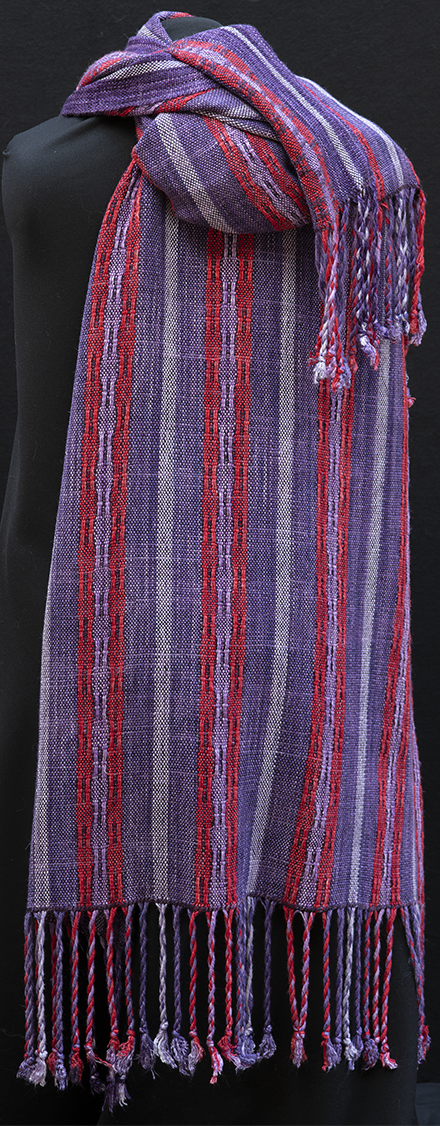
In a previous blog we talked about droppdräll being huck. We also compared huck the way we generally weave it now and the traditional threading, which is the way I learned. As a refresher here are the two drafts leading to the same drawdown.
Below on the left is the drawdown for the traditional huck, modern on the right.
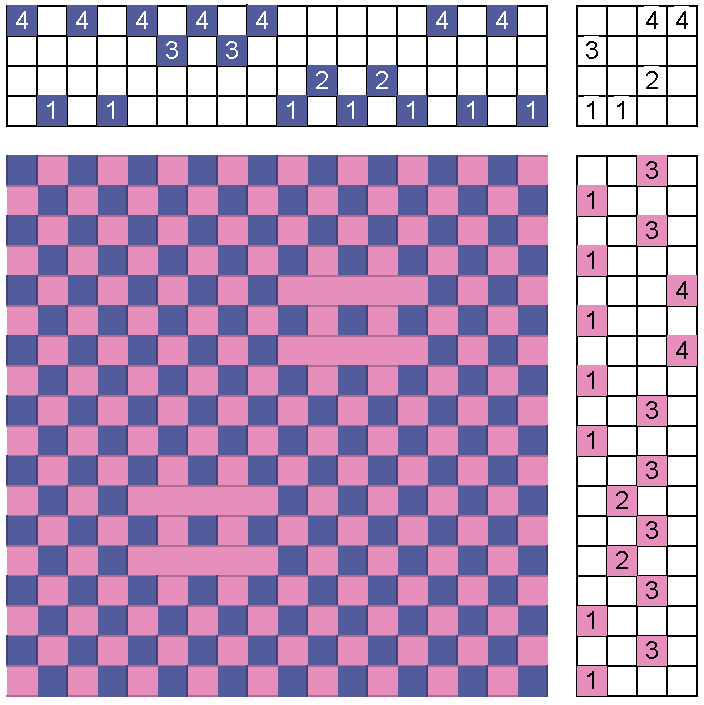 |
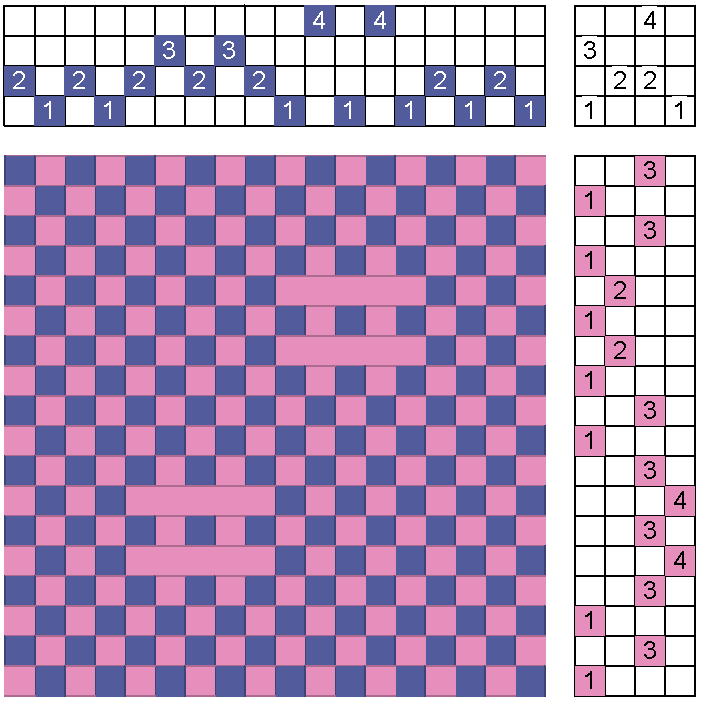 |
Do you see that Swedish Lace is three adjacent blocks of huck? When we want to thread more than one block in huck, we delimit the float with the alternate tabby. We can think of each block of huck in two ways: 1) five threads, alternating a tabby thread with a pattern thread, ending with the tabby; then we use the alternate tabby to delimit the float if we want to repeat the block; 2) six threads wide as Mary Black does, but that’s only true if a block is repeated. The float of a single block or of the end block in a sequence is delimited by the tabby starting the next block. That is shown in all the drawdowns above.
Thus, I have come to the conclusion that Swedish Lace is droppdräll, which is huck. Swedish designs are very clever in arranging the blocks in pleasing combinations. The Swedish Lace arrangement doesn’t surprise me. But the blocks are that of huck.
Clearly my silly story at the beginning of this blog is made up, but my imagination may not be too far from the truth. I still can’t pronounce droppdräll correctly, but unlike my fictional weavers, I will find out before Convergence™!
I hope to see you at Convergence®, maybe even in one of my seminars – vaccinated and masked, we will both be safe.
I would love to see you there!
Happy weaving!
Marcy
| Convergence® Amidst Endemic Covid-19 |
Marcy Petrini
May, 2022
After HGA released the Covid-19 safety guidelines for Convergence®, three kinds of questions have come up from folks planning to attend or thinking of attending. 1) why do we have to wear masks? 2) why not require everyone to be vaccinated? 3) why trust the recommendations when this keeps on changing? Ironically, the first two questions are on the opposite side of the issue:
As a retired health care professional doing research and teaching for over 30 years and coming from a very high-risk family (my Mom just turned 100!), I have been following the science and medicine of this pandemic and I would like to offer answers to these questions.
Why do we have to wear masks?
The single most important cause in getting Covid-19 is the virus load that you inhale. We catch the virus from droplets in the air. With just a few viruses, the immune system takes care of them; with lots of viruses, severe disease and even death can result. Inhalation of virus particles can occur whether you are vaccinated or not. We all know of breakthrough infections, people who are vaccinated and even boostered, and get the virus.
Large outbreaks have occurred with large gatherings where there are more virus-ladened droplets, even with the best of air handling.
Masks are the one factor we can do to decrease a possible virus load. Social distancing is great, but not always possible. Think of hallways.
No, it’s not fun to wear masks, but experts have said that this is not over yet; viruses mutate, we could have new outbreaks, and there are other diseases to be cautious about (i.e., bird flu). At the moment, we seem to be migrating from a pandemic to an endemic state, meaning the virus is here to stay. I would be wearing a mask even if HGA wouldn’t require it. It’s for my protection.
Why not require everyone to be vaccinated?
The short answer is: why? I am vaccinated and boostered for my protection. With many people attending, it is quite possible that some have the virus but are totally asymptomatic, whether they are vaccinated or not. It wouldn’t even have to be an attendee, it could be a hotel or convention center staff person. If I get the disease, I am less likely to die because I am vaccinated.
And yes, there are legal reasons, especially in the south, where many states have made it illegal for an entity to require vaccination. What we don’t want is for some person who is not vaccinated to sue HGA because they couldn’t attend!
The information keeps changing, how can I trust it?
I am watching a baseball game and an ad for a new drug appears. How wonderful, I think. What I don’t think about is how many changes that potential drug has undergone to become effective and safe, how may false starts there have been, how many trials, how many reviews, ending with the FDA one.
That evolution of a drug and the understanding of a disease occur behind the scenes, slowly and methodically and well, some may say, boring.
With Covid-19, a lot has been reported on the front page of our newspaper or tablet. As more information was found, our requirements changed. Science is often wrong, but self-correcting. If it weren’t self-correcting, we would still be using the drugs of the last century. What we didn’t see on the front page is the years of research – and failures – that RNA vaccines had undergone. So, yes, the Covid-19 vaccine was relatively fast, but knowledge about RNA vaccines had been amassed over decades.
I hope to see you at Convergence®, maybe even in one of my seminars – vaccinated and masked, we will both be safe.
I would love to see you there!
Happy weaving!
Marcy
| Sampling Droppdräll |
Marcy Petrini
April, 2022
After last months’ adventures in rediscovering the proverbial wheel, I wanted to weave some droppdräll. While droppdräll is huck, the Swedish variations and arrangements of the blocks are interesting. I repeat the drawdowns here to make it easier to see them with the fabrics.
I started with Edna Olson Healy’ s Droppdräll, published in the Lily’s Pamphlet Practical Weaving Suggestions One Color Upholstery Fabrics, Vol. 2-58, which is in the public domain and is available from the University of Arizona at this link:
https://www2.cs.arizona.edu/patterns/weaving/periodicals/pws_58_2.pdf
The sinking shed drawdown is below. I wove it first with a weft the same size as the warp (5/2 mercerized cotton).
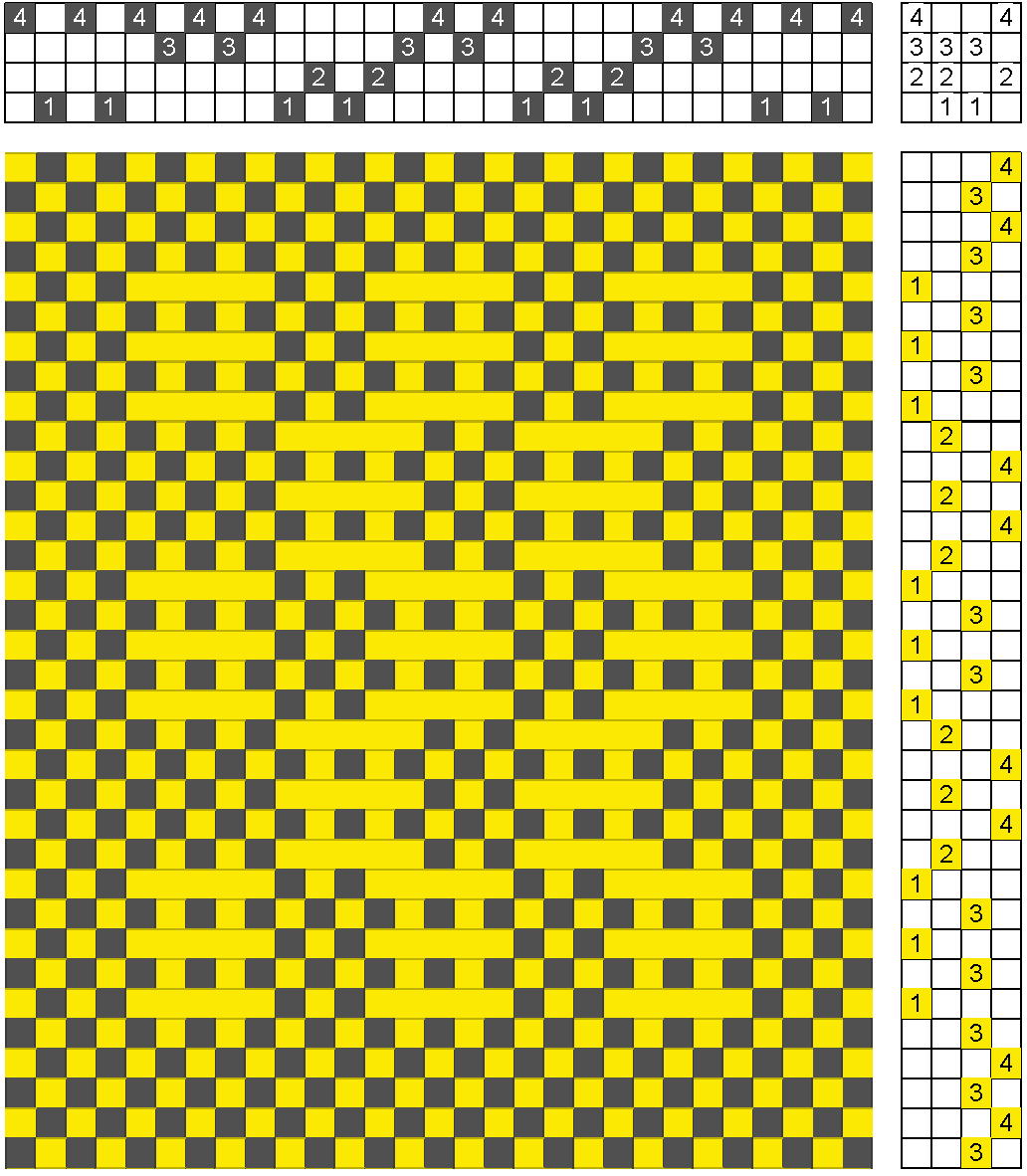
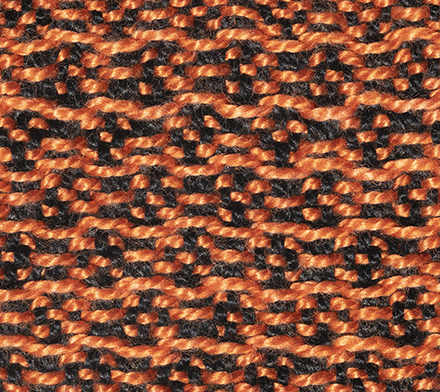
Then I wove with the weft floats of thicker yarn, as suggested by Olson Healy for upholstery. The tabby picks are still 5/2 cotton, the float picks are silk chenille.
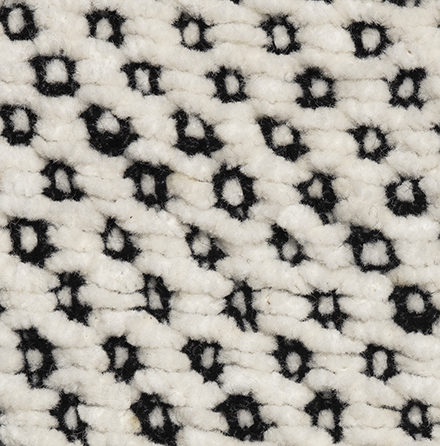
The second sample is indeed thick enough to be good upholstery fabric. Olson Healy uses motifs, rather than a continuous repeat of blocks as I have done, but the structure of the blocks is still visible.
To compare the droppdräll with huck, I made a sinking shed drawdown using the traditional threading and treadling steps of huck, shown below. The droppdräll has 4-thread for each block, rather than 5 of the huck; the treadling steps of the droppdräll lack the tabby that separates the blocks in huck. Interesting variation. I suppose we could argue that this is not huck, but if we look at the drawdowns, we see the characteristics blocks.
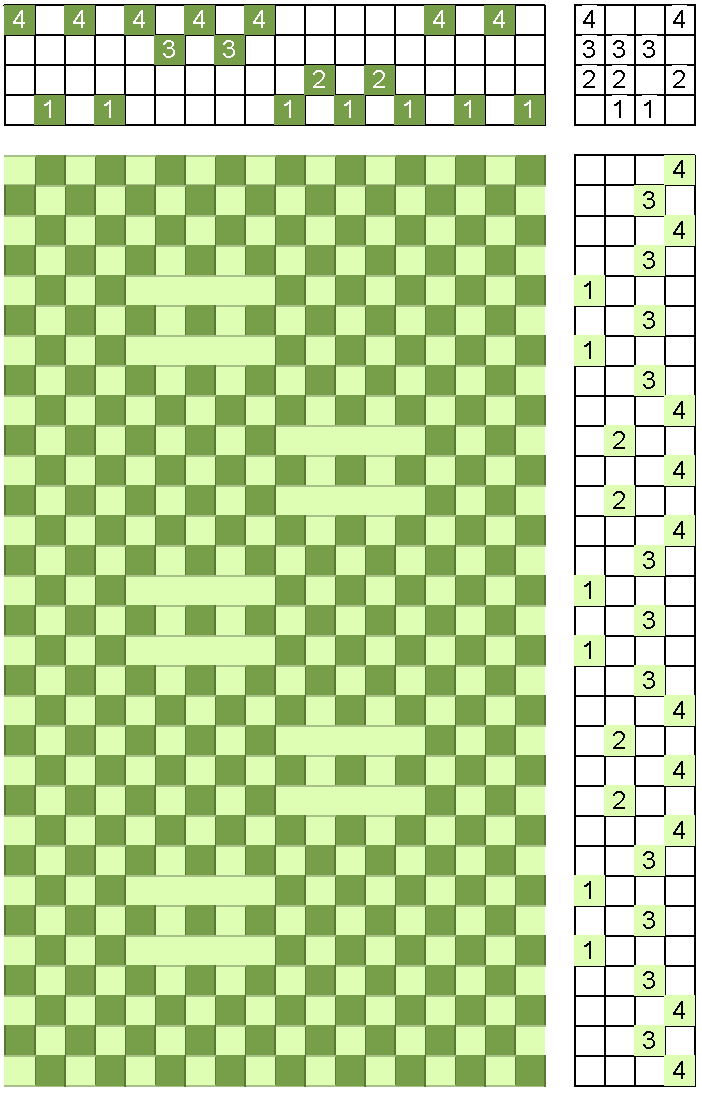
Next, I wanted to weave Adrianna Funk’s droppdräll (which she erroneously calls Bronson Lace in her website), and which is also (correctly identified) in the book To Weave the Swedish Way which she co-authored with Miriam Parkman. Below is the rising shed drawdown; she weaves the double picks with thicker yarn for texture. I followed those directions for the sample that is below the drawdown, the warp and tabby weft are 5/2 mercerized cotton, silk chenille for the fatter weft.
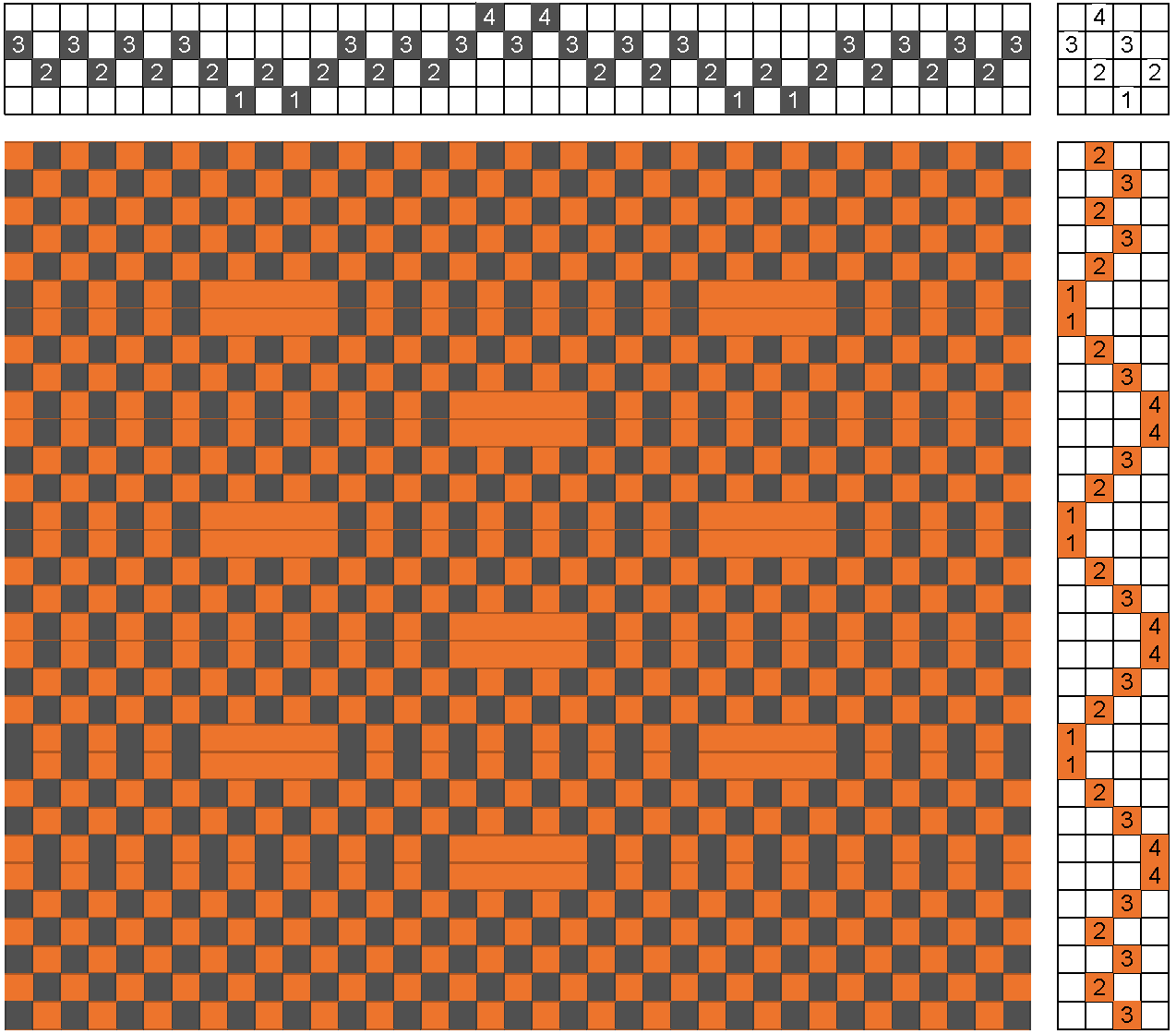
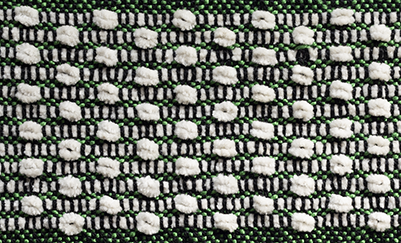
I modified Funk’s drawdown (rising shed), as shown below, by adding a tabby between the floats, highlighted in yellow; with this addition, the drawdown is undistinguishable from huck.

I wove the fabric shown below, using the same warp and weft.

The difference between the Funk’s droppdräll fabric and the huck fabric is that the double picks in the droppdräll result in visually more solid blocks; in huck they are separated by the tabby. However, the advantage of the huck is that floating selvages are not needed as they are in the droppdräll to catch the double pick.
The Weaving Handbook by Åsa Pärson and Amica Sunderström has interesting variation of droppdräll, but the one that intrigued me the most is the 3-thread structure. Below is the rising shed drawdown.

Both sides of the fabric are interesting, woven again with 5/2 cotton warp and weft. Here is the weft-float side:

Below the warp floats side:

I have woven for nearly 50 years, yet I still discover variations of one of my favorite structures. That’s what I love about weaving!
If you want to learn more, come to my seminar at Convergence®, I would love to see you there!
Happy weaving!
Marcy
